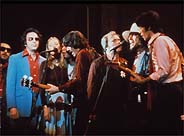
 |
PART of the pleasure of watching the new print of "The Last Waltz" is to see Martin Scorsese fall in love with his subject, the Band. And part of the pleasure is in watching Robbie Robertson, the group's leader, seduce Mr. Scorsese.
Mr. Robertson's heavy-lidded predatory charm is unlike that of any performer Mr. Scorsese has ever worked with. In interviews that are woven into the film — a rueful valedictory released in 1978 that records the Band's last performance, on Thanksgiving two years earlier — Mr. Robertson is supremely comfortable in his own skin, and this makes him a different kind of creature to Mr. Scorsese, who is the kind of guy who'd probably start twitching in a room full of nitroglycerine. Mr. Robertson is the director's dream version of himself.
You need only contrast Mr. Robertson with the director's other camera-ready alter ego at the time, Robert DeNiro. Mr. Scorsese had used Mr. DeNiro as a jittery provocateur, always throwing elbows and tantrums to prove himself. Mr. Robertson, by contrast, knows exactly who he is. He has the relaxed manner of a man who's never missed a party or a day's sleep. With his breeziness and hustler's savvy, Mr. Robertson is a rock 'n' roll version of Robert Mitchum, a guy so cool they named a deodorant after him.
But more than Mr. Robertson's emergence as a singular star, "The Last Waltz" is about the passing of a brand of music. I caught the new print of it at the South by Southwest Music Festival in Austin, Tex., last month, and the crowd applauded each song as if the musicians who had come to Bill Graham's Winterland in San Francisco to celebrate the Band — Eric Clapton, Bob Dylan, Joni Mitchell and Van Morrison among them — were jamming live.
The movie also offers the magic of Levon Helm, the group's drummer (and sometime mandolin player) who was just as gifted a storyteller as Mr. Robertson; the jagged beauty of Mr. Helm's voice, in contrast to the rich, control drollery of Mr. Robertson's, is mesmerizing.
The sound of "The Last Waltz" has been sweetened and tweaked; now you can more easily hear the gracefully distended playing of Pops Staples, one of the most underrated guitarists of all time, as the Staples back the Band on "The Weight," performing on a soundstage in a segment without an audience.
(Amusingly, the Staples' appearance is one of only two by black musicians in this film about a group that got its start doing tune-ups of bluesy roots music; Muddy Waters, with his all-beef swagger, is the other, in a concert that seems to regard Neil Diamond as the epitome of soul.)
"The Last Waltz" was the first film in which Mr Scorsese didn't pack the frame with the orgiastic tension and grandililoquent flamboyance that he had been known for. It was a tonic antidote to the cranked up cheekiness of Mr. Scorsese's "New York, New York," a musical (with Mr. DeNiro) that he was editing around the time he shot "The Last Waltz."
GIVEN that Mr. Scorsese was — and still is — drawn to movies that are filled with emotional dissonance and peopled with defiant protagonists, it must have been a thrill to work with the Band. The ruthless straightforwardness of the group was no doubt a balm to Mr. Scorsese's anxious skin. Onstage, the Band's members — the others were Garth Hudson, Richard Manuel and Rick Danko — have the lean, rough hunger of veteran gunfighters who know they still have a few throwdowns left in them but who had chosen to walk away while their bodies were still intact.
And yet seen today, there's a preserved-in-amber feeling to the film, and the bluesy tint of the songs seems more appropriate than ever in retrospect.
"The Last Waltz" was made at a time when rock concert movies were often made by people who'd cobbled together enough dough to genuflect with vertiginous hand-held camera work. The unspoken point of these movies was that you might as well get toasted to watch them, because the bob-and-weave cinematography made it seem as if you were stoned anyway.
Mr. Scorsese's technique was a measured formality — one that seems even more quaint now than when the picture was first released. The courtliness contradicts the shaggy joy of the singers, who step onto the stage and have a marrow-deep confidence in themselves, too. The supreme joy can be seen in performances like Mr. Morrison's, in which he flings his limbs in what can only be called an Irish approximation of funk. He's like a happy, dancing Butterball Turkey.
There are few concert movies that were filmed were such abiding feeling and respect. It's of a potent vintage that goes down deceptively smoother with age.